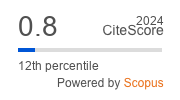FEATURES OF SILICON DOPING BY THE THERMOMIGRATION METHOD
https://doi.org/10.17073/1609-3577-2015-3-179-188
Abstract
Characteristics of crystal doping with electrically active impurities by the thermomigration method for two− and three−component liquid zones in comparison with diffusion alloying (for the example of silicon) have been analyzed.
We have found that the concentration range of doping for the two− component migration zone is much narrower than the range of diffusion doping. Introduction of a third component into the liquid phase allows extending the range of doping thermomigration to values exceeding the diffusion doping range for the same impurity. For silicon crystals this technological advantage of thermomigration is achieved with the use of three zones, GaxAl1−xSi and SnxAl1−xSi.
We show that the speed of crystal doping by the thermomigration method in technologically relevant situations is by orders of magnitude higher than that of diffusion alloying. Thermomigration doped layers with steadily moving liquid zones have higher structural perfection than diffusion doped layers.
We show that the thermomigration alloying method can be used in the technology of semiconductor device structures, provided that their planar dimensions and thickness are tens micrometers or more. Quantitative results obtained for the example of liquid zone migration in silicon, but the features of thermomigration as a doping method are true for other semiconductor materials.
About the Authors
V. N. LozovskyRussian Federation
Vladimir N. Lozovsky — Dr. Sci. (Phys.−Math.), Professor
L. S. Lunin
Russian Federation
Leonid S. Lunin — Dr. Sci. (Phys.−Math.), Head of the Department of Nanotechnology in Electronics
B M. Seredin
Russian Federation
Boris M. Seredin — Cand. Sci. (Eng.), Associate Professor
References
1. Kozhitov L. V., Kosushkin V. G., Krapuhin V. V., Parhomenko Yu. N. Tehnologija materialov mikro− i nanojelektroniki [Materials technology of micro− and nanoelectronics]. Moscow: MISiS, 2007. 544 p. (In Russ.)
2. Chernjaev V. N. Tehnologija proizvodstva integral’nyh mikroshem i mikroprocessorov [Technology of production of integrated circuits and microprocessors]. Moscow: Radio i svjaz’, 1987. 464 p. (In Russ.)
3. LozovskiyV. N., Lunin L. S., Popov V. P. Zonnaja perekristallizacija gradientom temperatury poluprovodnikovyh materialov [Temperature −gradient zone recrystallization of semiconductor materials]. Moscow: Metallurgy, 1987. 232 p. (In Russ.)
4. Lunin L. S., Blagin A. V., Alfimova D. L., Popov A. I., Razumovskij P. I. Fizika gradientnoj jepitaksii poluprovodnikovyh geterostruktur [Physics gradient epitaxy of semiconductor heterostructures]. Rostov−na−Donu: Izd−vo SKNC VSh, 2008. 235 p. (In Russ.)
5. Barannik A. A., Blagina L. V., Draka O. E., Podshhipkov D. G. Fiziko− himicheskie osnovy poluchenija mnogokomponentnyh poluprovodnikov s zadannoj substrukturoj [Physico−chemical principles of the multicomponent semiconductors with a given substructure]. Rostov−na−Donu: Iz−vo SKNC VSh, 2009. 204 p. (In Russ.)
6. Lozovskij V. N., Poluhin A. S., Molibog N. P., Evseev Ju. A. Ispol’zovanie zonnoj perekristallizacii gradientom temperatury v tehnologii poluprovodnikovyh priborov [Use of zone recrystallization temperature gradient in the technology of semiconductor devices]. Jelektrotehn. prom−st’. Ser. 05. Poluprovodnikovye silovye pribory i preobrazovateli na ih osnove: obzor. inform. 1987, vol. 6 (16), pp. 1—48. (In Russ.)
7. Polukhin A. S., Baljuk A. V., Seredin L. M., Seredin B. M. Struktury s razdelennymi p+ −oblastjami dlja silovyh poluprovodnikovyh priborov na toki do 100 A [Patterns with separated p+ − regions for semiconductor power devices at currents up to 100 A]. Kristallizacija i svojstva kristallov. Mezhvuz. sb. nauch. tr. Platov South−Russian State Polytechnic University (NPI). Novocherkassk: Nabla, 2003. Pp. 120—124. (In Russ.)
8. Polukhin A. S., Zueva T. K., Solodovnik A. I. The use of thermomigration in technology structures of power semiconductor devices. Silovaja elektronika. 2006, vol. 3(9), pp. 110—112. (In Russ.)
9. Polukhin A. S. Thermomigration undirected linear zones in silicon wafers (100) to manufacture chips of power semiconductor devices. Komponenty i tekhnologii. 2008, vol. 11, pp. 97—100. (In Russ.)
10. Poluhin A. S. Analysis of the technological factors of the thermomigration process. Silovaja elektronika. 2013, vol. 5, pp. 118—120. (In Russ.)
11. Benjam in Mor illon . Etude de la ther mom igration de l’aluminium dans le silicium pour la réalisation industrielle de murs d’isolation dans les composants de puissance bidirectionnels. Micro and nanotechnologies/Microelectronics. INSA de Toulouse, 2002. 222 р. URL: https://tel.archives−ouvertes.fr/tel−00010945 (accessed 5 November 2014).
12. Malkovich R. Sh. Matematika diffuzii v poluprovodnikah [Mathematics of diffusion in semiconductors]. SPb: Nauka, 1999. 389 p. (In Russ.)
13. Lozovskiy V. N., Seredin B. M. The physical aspects of the choice of thermomigration as a method local doping of crystals. Fundamental’nye issledovanija. 2015, vol. 3, pp. 111—118. (In Russ.)
14. Diagrammy sostojanij dvojnyh metallicheskih sistem: Spravochnik [Statecharts binary metallic systems]. V 3 tomach. Pod red. N. P. Ljakisheva. Moscow: Mashinostoroenie, 1996. (In Russ.)
15. Evseev Ju. A., Dermenzhi P. G. Silovye poluprovodnikovye pribory [Power semiconductor devices]. Moscow: Jenergoatomizdat, 1981. 472 p. (In Russ.)
Review
For citations:
Lozovsky V.N., Lunin L.S., Seredin B.M. FEATURES OF SILICON DOPING BY THE THERMOMIGRATION METHOD. Izvestiya Vysshikh Uchebnykh Zavedenii. Materialy Elektronnoi Tekhniki = Materials of Electronics Engineering. 2015;18(3):179-188. (In Russ.) https://doi.org/10.17073/1609-3577-2015-3-179-188





































